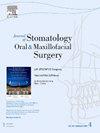MRE11 作为头颈部鳞状细胞癌的可信生物标记和预后生物指标。
IF 1.8
3区 医学
Q2 DENTISTRY, ORAL SURGERY & MEDICINE
Journal of Stomatology Oral and Maxillofacial Surgery
Pub Date : 2024-10-01
DOI:10.1016/j.jormas.2024.101970
引用次数: 0
摘要
目的:头颈部鳞状细胞癌(HNSCC)在全球癌症发病率中排名第六。MRE11 蛋白含有多个结构域,在启动 DNA 修复中发挥作用。本研究旨在阐明MRE11在HNSCC中的表达和预后意义:研究首先使用了由520个HNSCC组织和44个正常组织组成的癌症基因组图谱(TCGA-HNSCC)数据集来评估MRE11表达与临床病理特征之间的关联。采用 Kaplan-Meier 图进行生存分析。利用肿瘤免疫估算资源(TIMER)数据库分析了 MRE11 与免疫细胞的相互作用。此外,还利用 Insilco 方法探索了蛋白质网络及其与其他通路的关联。利用定量反转录 PCR(RT-qPCR)验证了患者样本中口腔鳞状细胞癌(OSCC)组织中 MRE11 mRNA 的表达:结果:MRE11在HNSCC中表达上调,其表达在不同临床分期、病理分级和初始治疗结果中存在显著差异。此外,MRE11的高表达与较差的生存结果相关。MRE11的过表达还与HIPPO信号通路、mTOR信号通路和MYC/MYCN信号通路的激活有关:结论:MRE11可被视为HNSCC的一种新型预后生物标志物,利用它可获得良好的治疗效果。这项研究强调了MRE11是HNSCC的新型分子生物标记物,并为其治疗提供了新的方向,即明确针对MRE11及其网络进行治疗干预。本文章由计算机程序翻译,如有差异,请以英文原文为准。
MRE11 as a plausible biomarker and prognostic bioindicator for head and neck squamous cell carcinoma
Objective
Head and Neck Squamous Cell Carcinoma (HNSCC) ranks as the sixth most prevalent form of cancer worldwide. MRE11 protein contains multiple domains that play a role in the initiation of DNA repair. This study aimed to elucidate the expression and prognostic significance of MRE11 in HNSCC.
Material and methods
The Cancer Genome Atlas (TCGA-HNSCC) dataset comprising 520 HNSCC tissues and 44 normal tissues was initially used to evaluate the association between MRE11 expression and clinicopathologic characteristics. Kaplan–Meier plot was utilized for survival analysis. MRE11-immune cell interaction was analyzed using Tumor Immune Estimation Resource (TIMER) database. Further, Insilco methods were used to explore the protein network and its association with other pathways. Quantitative reverse transcription PCR (RT-qPCR) was used to validate the MRE11 mRNA expression in oral squamous cell carcinoma (OSCC) tissues in patient samples.
Results
MRE11 expression was upregulated in HNSCC, and the expression significantly varied across different clinical stages, pathological grades, and initial treatment outcomes. Further, high MRE11 expression is associated with poorer survival outcomes. MRE11 overexpression is also linked to the activation of the HIPPO signaling pathway, the mTOR signaling pathway, and the MYC/MYCN signaling pathway.
Conclusion
MRE 11 can be considered a novel prognostic biomarker for HNSCC, which can be leveraged for promising treatment outcomes. This research highlights MRE11 as a novel molecular biomarker for HNSCC and offers a new direction for its treatment, explicitly targeting MRE11 and its network for therapeutic intervention.
求助全文
通过发布文献求助,成功后即可免费获取论文全文。
去求助
来源期刊

Journal of Stomatology Oral and Maxillofacial Surgery
Surgery, Dentistry, Oral Surgery and Medicine, Otorhinolaryngology and Facial Plastic Surgery
CiteScore
2.30
自引率
9.10%
发文量
0
审稿时长
23 days
 求助内容:
求助内容: 应助结果提醒方式:
应助结果提醒方式:


